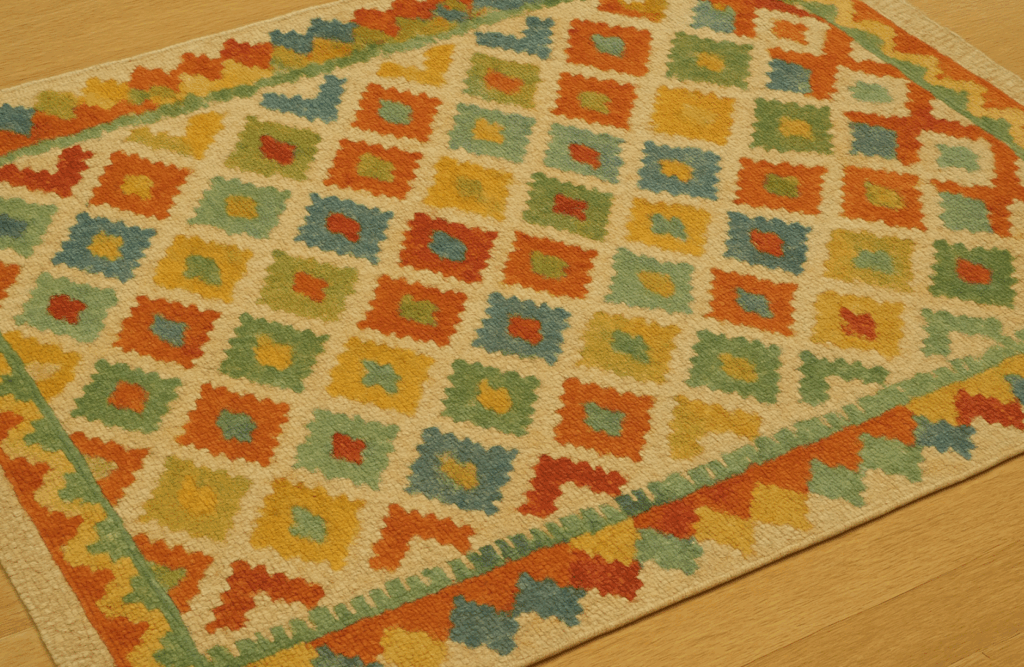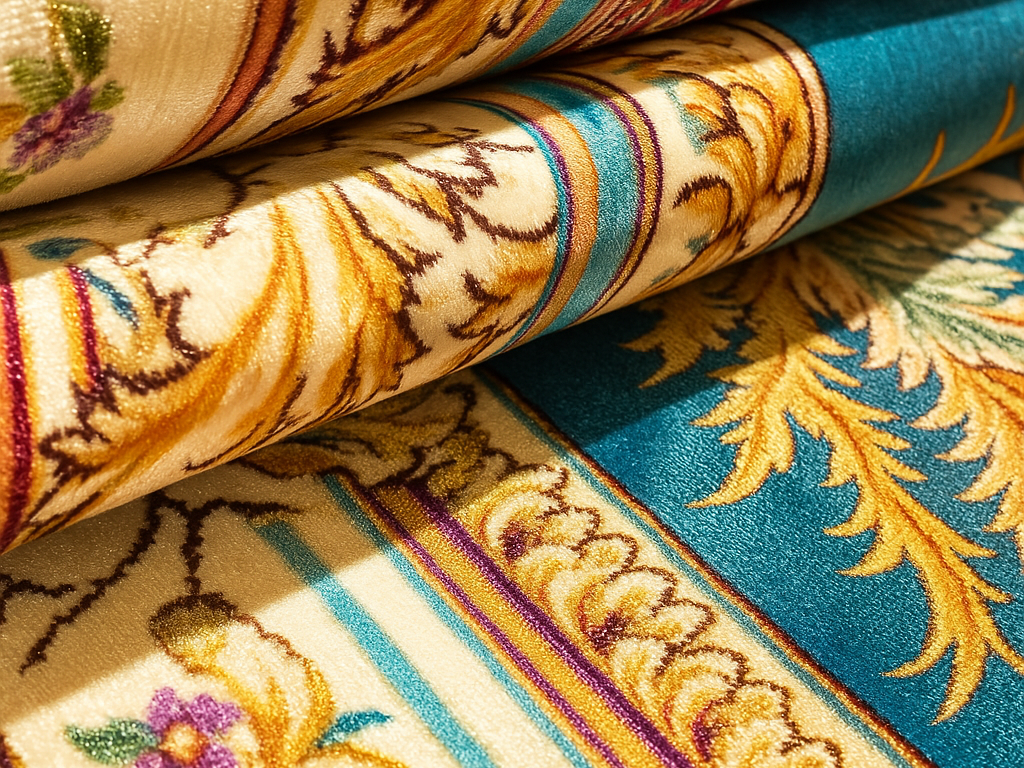Les tapis en laine sont depuis longtemps réputés pour leur beauté intemporelle, leur durabilité exceptionnelle et leur toucher luxueux. Que vous souhaitiez ajouter de la chaleur à un salon, délimiter une salle à manger ou apporter de la texture à une chambre à coucher, un tapis en laine peut rehausser votre espace. Mais avec autant d'options disponibles, comment choisir le bon ? Ce guide vous aidera à comprendre ce qu'est un tapis en laine et à trouver celui qui vous convient le mieux chez Valhak.

1. Qu'est-ce qu'un tapis en laine ?
A tapis en laine est un revêtement de sol fabriqué principalement à partir des fibres naturelles de la laine de mouton. Ces fibres sont transformées en fil, puis tissées ou tuftées pour créer différents motifs et textures. Les tapis de laine peuvent être fabriqués à l'aide de différentes techniques, notamment le nouage à la main, le tuftage à la main et le tissage à la machine, chacune offrant des caractéristiques uniques en termes de durabilité, de texture et d'apparence.
Types de laine utilisés dans les tapis
- Laine de Nouvelle-Zélande: Réputé pour sa douceur et son élasticité, il constitue un choix de premier ordre pour les tapis de haute qualité.
- Laine indienne: Souvent utilisé dans les conceptions traditionnelles, il offre un équilibre entre la qualité et le prix.
- Laine afghane: Connu pour sa durabilité et sa texture riche, il est couramment utilisé dans les tapis de style tribal et ancien.
- Laine locale: Provenant de différentes régions, chacune d'entre elles offre des textures et des qualités distinctes.
2. Pourquoi choisir un tapis en laine ?
Tapis en laine offrent une multitude d'avantages qui en font un choix privilégié pour de nombreux propriétaires :
- Durabilité: La laine est naturellement résistante et peut supporter un trafic piétonnier intense sans montrer de signes d'usure. Les fibres sont solides et peuvent conserver leur forme pendant des années, résistant à l'écrasement et à l'aplatissement.
- Isolation naturelle: Les fibres de laine ont des propriétés isolantes qui permettent de réguler les températures intérieures en gardant les espaces chauds en hiver et frais en été.
- Résistance aux taches: La lanoline naturelle de la laine agit comme une barrière contre les taches, ce qui rend les tapis en laine plus faciles à nettoyer et à entretenir.
- Respect de l'environnement: La laine est une ressource renouvelable et biodégradable dont l'empreinte carbone est faible, ce qui en fait un choix respectueux de l'environnement.
- L'attrait esthétique: Les tapis en laine se déclinent en une large gamme de motifs, de couleurs et de textures, ce qui vous permet de trouver l'accord parfait avec votre décoration intérieure.
3. Facteurs à prendre en compte lors de l'achat d'un tapis en laine
Pour choisir le tapis en laine idéal, il faut évaluer soigneusement divers facteurs afin de s'assurer qu'il complète votre espace, qu'il répond à vos besoins fonctionnels et qu'il correspond à vos préférences esthétiques. Voici un examen approfondi des principaux facteurs à prendre en compte :

Type de pile
Le velours est la couche superficielle du tapis, celle sur laquelle on marche. Il influe considérablement sur l'aspect du tapis et sur son adaptation aux différentes pièces de la maison.
Pile coupée: Ce type de revêtement comporte des fils qui sont cisaillés pour créer une surface douce et moelleuse. Il est idéal pour les zones où le confort est primordial, comme les chambres à coucher ou les salons.
Loop Pile: Dans les tapis à poils bouclés, les fils ne sont pas coupés, ce qui forme des boucles. Cette construction rend le tapis plus durable et plus résistant à l'usure, ce qui le rend adapté aux zones très fréquentées comme les couloirs et les entrées.
Tissage à plat: Les tapis à armure plate sont tissés sans poils, ce qui donne un tapis fin et léger. Ils sont faciles à nettoyer et à entretenir, ce qui en fait un choix pratique pour les espaces tels que les cuisines ou les salles de bains.
Technique de tissage
La méthode utilisée pour tisser le tapis influe sur sa texture, sa durabilité et sa qualité générale.
- Noué à la main: Chaque nœud est fait à la main, ce qui permet d'obtenir un tapis dense et durable aux motifs complexes. En règle générale, plus un tapis noué à la main contient de nœuds par pouce carré, plus il est de qualité. Des concentrations plus denses de nœuds créent un dessin et une texture plus agréables et plus élaborés, et plus les nœuds sont serrés, plus le tapis est durable.
- Touffeté à la main: Le fil est perforé dans un support en toile, ce qui permet une production plus rapide et un prix plus abordable. Bien qu'ils ne soient pas aussi durables que les tapis noués à la main, ils offrent néanmoins une bonne qualité et une grande souplesse de conception.
- Fabriqué à la machine: Fabriqués à l'aide de procédés automatisés, ces tapis sont rentables et se déclinent en une grande variété de motifs. Toutefois, ils ne peuvent pas rivaliser avec le savoir-faire et la longévité des tapis faits à la main.
Hauteur et densité des pieux
- Hauteur de la pile: Se réfère à la longueur des fils. Les tapis à poils ras sont plus durables et plus faciles à nettoyer, tandis que les tapis à poils hauts offrent un toucher plus doux et plus luxueux.
- Densité: Indique à quel point les fils sont serrés les uns contre les autres. Une densité plus élevée est souvent synonyme de meilleure qualité, car le tapis sera plus durable et plus résistant à l'usure.
Taille et forme
Choisir la bonne taille La forme du tapis permet de s'adapter à l'espace et de compléter l'agencement des meubles.
- Taille: Mesurez soigneusement votre espace. Un tapis trop petit peut donner l'impression d'une pièce décousue, tandis qu'un tapis trop grand peut envahir l'espace.
- Forme: Les tapis rectangulaires sont les plus courants, mais les tapis ronds, carrés et à patins peuvent ajouter un intérêt visuel et sont adaptés à des zones spécifiques, comme sous une table à manger ronde ou le long d'un couloir.
Couleur et design
La couleur et le dessin du tapis doivent s'harmoniser avec le décor existant.
- Couleur: Les tons neutres comme le beige, le gris ou l'ivoire s'intègrent parfaitement à différentes combinaisons de couleurs. Les couleurs vives peuvent s'imposer et servir de point de mire à une pièce.
- Conception: Les motifs traditionnels, tels que les motifs persans ou orientaux, apportent une touche classique. Les motifs géométriques ou abstraits modernes peuvent apporter une touche contemporaine.
Indicateurs de qualité
Pour évaluer la qualité d'un tapis en laine, il faut tenir compte de plusieurs facteurs :
- Sheen: Une brillance naturelle peut être le signe d'une laine de haute qualité.
- Texture: Le toucher du tapis doit être lisse et ferme, pas cassant ni grossier.
- Frange: Vérifiez l'intégrité de la frange. Une frange faible ou effilochée peut être le signe d'une mauvaise exécution.
- Soutien: Inspectez le dossier pour déceler tout signe d'usure ou de détérioration. Un dos solide et bien construit contribue à la durabilité du tapis.
Maintenance et entretien
Un bon entretien garantit la longévité de votre tapis en laine.
- Nettoyage: Il est essentiel de passer régulièrement l'aspirateur. Utilisez un aspirateur à succion uniquement pour éviter d'endommager les fibres.
- Traitement des taches: Traiter rapidement les déversements. Épongez la zone touchée avec un chiffon propre et sec et utilisez un nettoyant sans danger pour la laine si nécessaire.
- Rotation: Tournez le tapis régulièrement pour assurer une usure régulière et éviter la décoloration due à la lumière du soleil.
- Nettoyage professionnel: Envisagez un nettoyage professionnel tous les deux ans pour préserver l'aspect et l'état du tapis.
Considérations environnementales
La laine est une ressource naturelle et renouvelable, ce qui fait des tapis en laine un choix écologique. Toutefois, il est important de tenir compte des processus d'approvisionnement et de fabrication.
- Pratiques durables: Recherchez des tapis fabriqués selon des méthodes respectueuses de l'environnement, telles que des teintures à faible impact et une récolte durable de la laine.
- Certifications: Des certifications telles que le Global Organic Textile Standard (GOTS) peuvent indiquer le respect de normes environnementales et sociales.
4. Quand choisir un tapis en laine ?
Les tapis en laine sont polyvalents et peuvent être choisis pour diverses raisons :
- Zones à fort trafic: Leur durabilité permet de les utiliser dans les salons, les couloirs et les entrées.
- Problèmes d'allergie: La laine est naturellement résistante aux acariens et aux allergènes, ce qui en fait un bon choix pour les personnes sensibles.
- Confort saisonnier: Les propriétés isolantes de la laine la rendent confortable tout au long de l'année, offrant chaleur en hiver et respirabilité en été.
- Vie durable: Si vous cherchez à faire des choix écologiques, les tapis en laine sont une option renouvelable et biodégradable.
5. Trouvez les meilleurs tapis en laine chez Valhak
Au ValhakAvec notre collection de tapis en laine, nous proposons une sélection de tapis en laine de haute qualité qui s'adaptent à différents styles et préférences. Que vous recherchiez un tapis traditionnel noué à la main ou un modèle contemporain, notre collection allie savoir-faire artisanal et durabilité. Explorez notre gamme pour trouver le tapis en laine qui s'harmonisera parfaitement avec votre intérieur.
6. Conclusion
Investir dans un tapis en laine est une décision qui apporte des avantages esthétiques et pratiques à votre maison. Grâce à leur durabilité, à leur isolation naturelle et à leur attrait intemporel, les tapis en laine constituent un complément polyvalent à tout espace. En tenant compte de facteurs tels que le type de poils, la technique de tissage et le design, vous pouvez choisir un tapis qui rehausse votre intérieur tout en répondant à vos besoins fonctionnels.
7. FAQ
1. Les tapis en laine sont-ils faciles à nettoyer ?
Oui, les tapis en laine sont naturellement résistants aux taches et à la saleté. Un passage régulier de l'aspirateur et un nettoyage professionnel occasionnel peuvent leur permettre de conserver leur éclat.
2. Les tapis en laine perdent-ils leurs poils ?
Il est normal que certains tapis perdent leurs poils, en particulier les tapis en laine neufs. Un passage régulier de l'aspirateur permet de réduire ce phénomène.
3. Les tapis en laine peuvent-ils être utilisés dans des zones très fréquentées ?
Absolument. Les tapis en laine sont durables et peuvent supporter un trafic piétonnier intense, ce qui les rend adaptés aux salons et aux couloirs.
4. Les tapis en laine sont-ils hypoallergéniques ?
La laine est naturellement résistante aux acariens et aux allergènes, ce qui en fait un bon choix pour les personnes sensibles.
5. Quelle est la durée de vie des tapis en laine ?
S'ils sont bien entretenus, les tapis en laine peuvent durer des décennies et s'embellir avec le temps.


